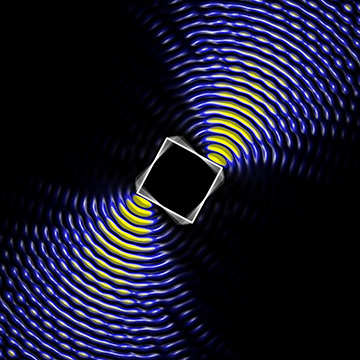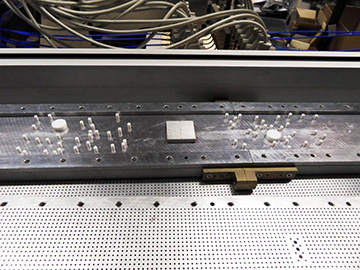
By shaping the intensity distribution of the electric field component of light, optical tweezers can apply a well-defined torque to a microscopic target. A team at TU Wien has created a method for rapidly calculating and shaping these fields, to allow for better control in scattering environments, such as biological tissue. [Image: TU Wien]
Optical tweezers—the Nobel Prize–winning technology whereby light beams can manipulate molecules or small biological particles—have been limited to work in empty space or in transparent liquids. Any disturbance that would deflect the light fields forming the tweezers, as might happen in strongly scattering biological samples, would destroy their effect.
Now, a research team at the Institute for Theoretical Physics at Technische Universität Wien (TU Wien), Austria, has developed a method to calculate the optimal wave field for manipulating small particles in a disordered environment (Nat. Photon., doi: 10.1038/s41566-019-0550-z). The researchers say the method—akin to a universal remote control for everything small—makes it possible to hold, move or rotate individual particles inside a sample even if they cannot be touched directly.
Custom-shaping tweezer light
To achieve this, team leader Stefan Rotter explains, the particle and its disordered environment are first illuminated with various waves, and the way in which the waves are reflected is measured. This measurement is carried out twice in quick succession.
“Let’s assume that in the short time between the two measurements, the disordered environment remains the same, while the particle we want to manipulate changes slightly,” says Rotter. If a cell, for example, moves or sinks slightly, he continues, “the light waves we send in are reflected a little bit differently in the two measurements.” This tiny difference is crucial: With the TU Wien team’s new method, it’s possible to calculate the wave that is optimally suited to accelerate or slow down this particle movement.
“If the particle sinks downwards, we can calculate a wave that prevents this sinking or lets the particle sink even faster,” explains Rotter. “If the particle rotates a little bit, we know which wave transmits the maximum angular momentum.” That information allows the researchers to custom-shape a light field to rotate the particle without touching it.
Fragile samples beat the heat
“Our technique could be used in a holographic optical tweezer setup, to bring the stiffness of optical traps to their theoretical maximum for a fixed input power, as well as for particles of arbitrary shape embedded in an arbitrarily complex environment,” says the study’s first author, Michael Horodynski. He adds that this ability to tweak the power settings at a fine scale represents another possible advantage of the technique in working with fragile biological samples.
“Heating a trapped particle is a major obstacle at the moment for biological cells—too much heat destroys them,” says Horodynski. “We hope to provide optical tweezers that are strong enough, without requiring so much input power that it destroys the sample.”
Calculating bottlenecks
Horodynski says the technique has two major drawbacks: The need to capture as much outgoing light from the experiment as possible, and the requirement to measure the system’s scattering matrix on very short timescales, comparable to those at which the system itself changes. For non-static environments like living tissue, the scattering-matrix measurement and the calculations must be performed continuously to have the optimal field at every time step.
“The bottleneck is typically not the time it takes us to perform the calculations for our optimal input state based on a given scattering matrix,” Horodynski says. “Rather, it is the acquisition time of the scattering matrix itself that is still too long. The corresponding tools and hardware, however, are continuously improving at a fast pace.”
A microwave proof-of-concept
Aluminium waveguide with a quadratic target in the middle (the cover plate is removed and not shown). The white Teflon elements to the left and right of the target mimic a disordered medium. [Image: TU Wien] [Enlarge image]
In a proof-of-concept experiment carried out at the Institut de Physique de Nice, France, Kevin Pichler, another member of the TU Wien research team, tested the calculation method by irradiating randomly arranged Teflon objects with microwaves. Based on the experimentally measured signals, he was able to generate exactly those waveforms that produced the optimal wave states in the presence of the disorder in the system.
“In our proof-of-concept study we worked with microwaves because they provide us easy access to both the radiation in the far field, to measure the scattering matrix, and to the near field around the target, to see how the target is affect by the field,” Horodynski explains.
Rotter reports that the research team is now collaborating with an experimental group on applying the technique in the visible-light regime, to optimize the stiffness of an optical trap. But he also believes that the insight the technique provides raises “many more interesting possibilities in which way this could be extended—with the eventual goal being a real-time manipulation of arbitrary targets in a complex environment.”

